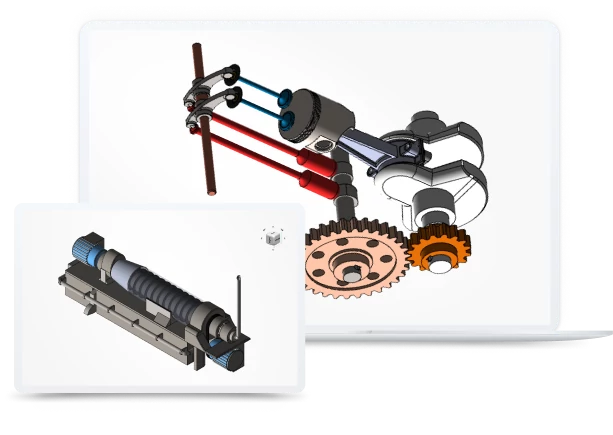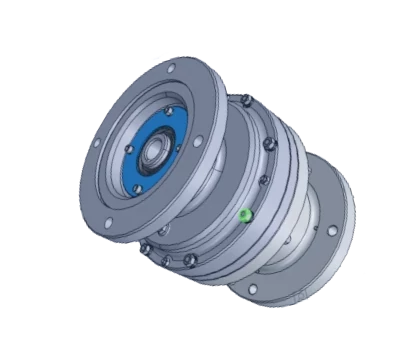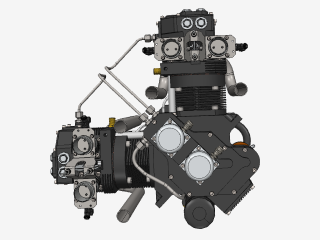

How to convert SOLIDWORKS
to Parasolid?
Applications for end-users. SDK's and tools for software developers. Custom development services for businesses.
Trusted by industry leaders







Available in CAD Exchanger Products
 CAD Exchanger Lab
CAD Exchanger Lab
Desktop app to view, explore and convert 3D CAD data across 30+ file formats
Learn more

SOLIDWORKS
SOLIDWORKS is a proprietary format, used by the SOLIDWORKS software, a professional 3D CAD software application. It utilizes the file extensions ".sldprt" for part files and ".sldasm" for assembly files. In this format, all the necessary geometric information, features, dimensions, constraints, and other design data are stored to represent and document a 3D model.
Support of SOLIDWORKS in CAD Exchanger
CAD Exchanger can read files from version 2004 to version 2025. Such support includes:
- B-Rep representations;
- polygonal representations (except for versions 2004, 2007, and 2008);
- assembly structure via external files;
- configurations;
- names;
- user-defined properties;
- graphical PMI (versions 2015-2022);
- colors.
Follow this link to check out all the CAD Exchanger products.
Pros of the format
Comprehensive design information
The SOLIDWORKS format contains comprehensive design information. It includes not only the 3D geometry of the part or assembly but also feature history, dimensions, constraints, materials, and other design parameters. This level of detail allows for easy modification, analysis, and collaboration within the SOLIDWORKS ecosystem.
Widely used in engineering and manufacturing
SOLIDWORKS is a widely adopted CAD software, and its proprietary format is supported by various CAD tools, engineering applications, and manufacturing processes. This compatibility ensures seamless data exchange and collaboration between different stakeholders, such as designers, engineers, and manufacturers. Using the SOLIDWORKS format facilitates effective communication and streamlines the workflow throughout the product development lifecycle.
Cons of the format
Proprietary Format
The SOLIDWORKS format is proprietary, meaning it is owned and controlled by Dassault Systèmes, the company behind SolidWorks. As we wrote above, this format is widely used in engineering and manufacturing, but there are still softwares and tools that do not support SOLIDWORKS, due to its proprietary nature. While SolidWorks does provide options to export to various standard formats like STEP or IGES, the main challenge is that neutral formats do not contain all the design information, but only the final result of the design process. Also, there may be challenges in maintaining full fidelity and compatibility when working with other CAD systems.
Numerous ".sldprt" and ".sldasm" files
Managing a large number of files when working with complex models can become challenging, especially when it comes to transferring data. Some files can be lost or deliberately hidden. Without all the files together, the user only has an approximate model geometry in the form of a polygonal mesh, but all design information, including the exact geometry, is missing.
FAQ
What are SOLIDWORKS file extensions?
The file extension ".sldprt" is used for SOLIDWORKS part files. They are the building blocks of assemblies and are created and modified within the SOLIDWORKS environment.
For assembly files, SOLIDWORKS uses the ".sldasm" extension. Assembly files represent the coming together of multiple parts into a larger, functional unit. They are essential for visualizing and analyzing the interaction between different components.
Drawing files in SOLIDWORKS have the ".slddrw" extension. These files contain 2D representations of parts or assemblies. They enable the generation of design documentation suitable for further usage in product lifecycle, in particular they serve as blueprints for creating physical parts.
SOLIDWORKS also utilizes template files for creating new documents. Template files have the extensions ".prtdot" for part templates and ".asmdot" for assembly templates. These files define the default settings, styles, formats, and other parameters for creating a new part or assembly documents.
Additionally, SOLIDWORKS features a library feature functionality that allows users to create reusable design elements. Feature files for library features use the ".sldlfp" extension. These files define specific features that can be applied to parts or assemblies, saving time and effort by enabling the reuse of complex or commonly used design elements.
How to open SOLIDWORKS file?
To open this file, you will need a compatible software application, for example, CAD Exchanger Lab. Launch the software and navigate to the 'New file' option. Browse your computer's directories and locate the file you want to open. Then select it and click "Open". Once the import process is complete, the file should be loaded into the software, allowing you to view and interact with the 3D model and associated data.
History of SOLIDWORKS format
The SOLIDWORKS format history dates back to the early 1990s when SolidWorks brand was founded by Jon Hirschtick. The goal was to create a user-friendly, parametric 3D modeling software that would revolutionize the CAD industry.
In 1995, the first version of SOLIDWORKS was released, introducing a groundbreaking approach to 3D modeling. As SOLIDWORKS gained popularity, it expanded its capabilities and introduced new features with each subsequent release. The software focused on improving design efficiency, accuracy, and collaboration.
In 1997, Dassault Systèmes, a renowned software company, acquired SolidWorks Corporation, bringing SOLIDWORKS into its product portfolio. The SOLIDWORKS format has become a standard in the CAD industry.
Today, SOLIDWORKS remains one of the most widely used CAD software packages, serving millions of users worldwide. Its continuous development, integration with other technologies, and commitment to user-friendly design have solidified its position as a leading CAD solution in the industry.
Parasolid
Parasolid file format is native for Parasolid geometrical kernel, a widely used 3D geometric modeling kernel developed by Siemens PLM Software. This kernel provides a set of advanced tools and algorithms for creating, editing, and analyzing complex models. Like any kernel, Parasolid also has a persistence format known as Parasolid-XT. The Parasolid format refers to the file format used to store and exchange 3D geometry data created using Parasolid.
Support of Parasolid files in CAD Exchanger
CAD Exchanger can import files starting from v0.15 and up to v35 and export files from v12 to v35. Such support includes:
- B-Rep representations;
- assembly structure;
- names;
- user-defined properties;
- colors;
- layers.
Follow this link to check out all the CAD Exchanger products.
Pros of the format
Kernel nature
The primary advantage of Parasolid-XT lies in its kernel-based architecture. When you need to import data into CAD software running on the Parasolid kernel, opting for this format is a wise decision. As a kernel format, Parasolid-XT excels in its handling of B-Rep geometry, demonstrating exceptional proficiency in storing intricate B-Rep models encompassing solids, sheets, wireframes, mixed components, and even non-manifold topologies.
A notable advantage over the ACIS-SAT format is its capacity to represent the model hierarchy, albeit with some limitations (parts and bodies are somewhat synonymous). Nevertheless, in essence, the conversion to Parasolid-XT has the potential to preserve your part-assembly hierarchies, adding to its appeal as a preferred choice.
Representation of hybrid models
Another notable capability is the endorsement of hybrid models, specifically those in which a single logical component encompasses both B-Rep and mesh geometry. While this scenario currently represents a relatively small portion of real-world data exchange, it's gaining popularity. Consequently, the Parasolid kernel has been actively advancing to embrace these models, with the most recent iterations of the Parasolid-XT format designed to handle them.
Cons of the format
Proprietary nature
Parasolid is a proprietary format owned and developed by Siemens PLM Software. This means that the specifications of the format are not publicly available, and only licensed software developers can fully access and utilize the features of Parasolid. While many CAD software applications support the import and export of Parasolid files, the lack of public specifications can limit the ability to develop custom tools or work with the format outside of the licensed software ecosystem.
The lack of extensive metadata and visual attributes support
Parasolid-XT offers some support for metadata and visual attributes, including the ability to name entities, assign colors to shapes, utilize layers, and user-defined properties as key-value pairs. However, if you're dealing with multi-body parts, PMI, or advanced metadata, it might be more beneficial to consider using alternative formats like STEP or JT. These formats provide more extensive support for those specific requirements.
FAQ
What are the benefits of using Parasolid format?
The Parasolid format offers exceptional interoperability, and precise B-rep modeling ensures high geometric accuracy, making it suitable for complex engineering and design tasks. Its wide industry adoption makes it a trusted and standardized format, ensuring compatibility and long-term support.
Which industries use Parasolid format?
The Parasolid format finds extensive use in various industries due to its versatility and precision. Industries such as aerospace, automotive, manufacturing, consumer electronics, and medical devices all rely on Parasolid for 3D modeling and design. Its broad adoption across these sectors facilitates the development of everything from aircraft components and automotive designs to medical implants.
What are the primary Parasolid file extensions?
In Parasolid, two primary file extensions are commonly used. The first one is .x_t (Parasolid Text), which represents a text-based format. It stores 3D geometric data in a text format, allowing for easy interoperability between different CAD systems. The second extension is .x_b (Parasolid Binary), which represents a binary format. .x_b files contain the same geometric information as .x_t files but in a more compact and faster-to-process binary format.
History of Parasolid format
The Parasolid format, as a file format for storing 3D geometry, has its own history. Developed by Shape Data Limited in the 1980s, the Parasolid format was designed to enable the exchange of 3D solid models between different CAD systems.
In 1996, the company was acquired by Unigraphics Solutions Inc., which eventually became part of Siemens PLM Software. Since then, Parasolid has continued to evolve and adapt, keeping up with the ever-changing demands of the CAD industry.
With its powerful capabilities and efficient representation of 3D geometry, Parasolid quickly became a standard format for CAD software developers. Its widespread acceptance can be attributed to its seamless interoperability. Many leading CAD software applications, including Siemens NX, Solid Edge, and SolidWorks, incorporate Parasolid as their underlying kernel, allowing users to create, modify, and exchange complex 3D models with ease.
Over the years, Parasolid has played a vital role in various industries, such as automotive, aerospace, and consumer goods. Its precision and accuracy have made it an indispensable tool for designers and engineers, enabling them to tackle intricate designs and perform detailed analyses. Today, Parasolid remains a cornerstone in the CAD landscape, empowering professionals to bring their creative ideas to life in the virtual world.
Convert SOLIDWORKS
to Parasolid
Need to work with CAD files in numerous formats? No worries.
From SOLIDWORKS to Parasolid, CAD Exchanger gets you covered.
What Our Delighted Customers Say
From Our Blog

Everything you need to know about CAD file formats
A CAD file is an output of a CAD software, containing key information about the designed object: its geometry and topology representation, 3D model hierarchy, metadata, and visual attributes depending on the format of the file.
Read more
Integration with UNIGINE engine
This article explores the integration possibilities with the UNIGINE engine, a powerhouse in the realm of virtual simulation and game development. Learn how it can be used in applications built with the UNIGINE engine to import CAD and 3D models.
Read more
Manufacturing Toolkit and Web Toolkit enhancements, Unity performance optimization, renaming and rotating SDK examples in release 3.24.0
Explore the wall thickness at a specific point on a surface, enjoy four times faster Unity objects performance, and check out renaming and rotating examples in SDK.
Read more